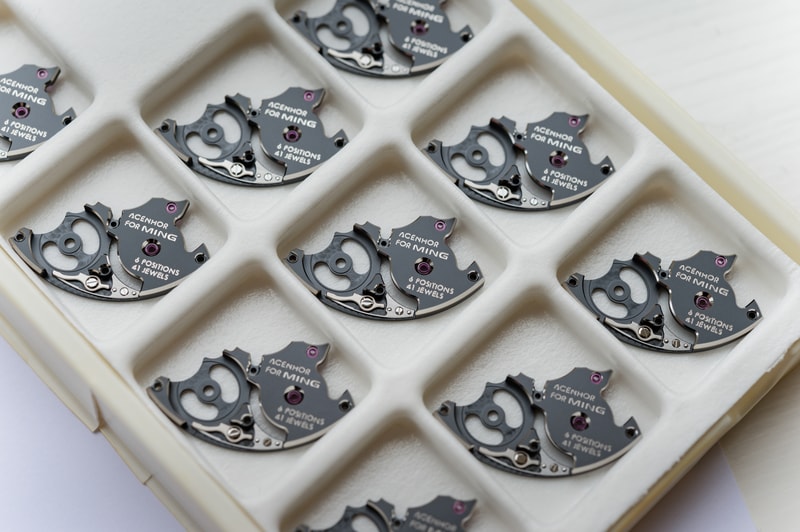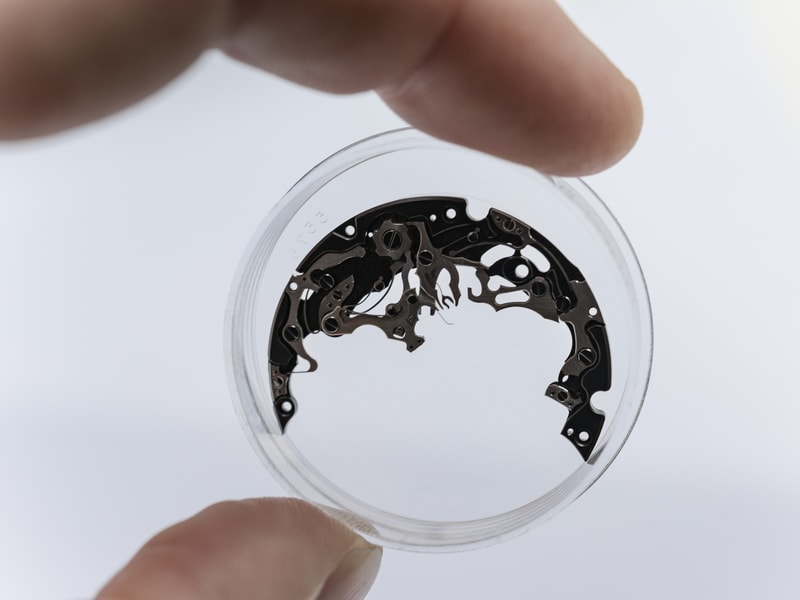
The AgenGraphe® is a turning point in the history of chronographs, which started in the early 19th century when Frenchmen Louis Moinet and Nicolas Mathieu Rieussec independently invented instruments to measure time intervals. In particular, Moinet’s Compteur de Tierces construction foreshadowed the ‘modern’ chronograph, with its split between central timing indications (fastest intervals) and those relegated to subdials (longer intervals) as well as its pusher-operated stop, start and reset functions. Two centuries later, these features remain the basic canvas in most mainstream chronographs.
Over time, improvements were made to this canvas, like the vertical clutch, which was introduced to address the stuttering during start/ stop of horizontal clutch chronographs caused by the (relatively) violent meshing of the gears. However, several weaknesses remained unresolved: poor legibility of the subdials, difficulty in reading elapsed times quickly due to the split of seconds, and longer intervals between the central pinion and the subdials, and mechanical issues like uneven power usage during operation and sensitivity of the mechanism to rough handling.
In 2016 (exactly 200 years after Louis Moinet), Jean-Marc Wiederrecht presented a chronograph movement which addressed all of the above drawbacks at once: the AgenGraphe®. This chronograph did not need to have subdials, an achievement all on its own. But this was just the start of how Wiederrecht and his team had radically rethought the chronograph. The major advancements made by the AgenGraphe® include:
1. Intuitive readability
With the AgenGraphe®, all chronograph indications (seconds, minutes, and depending on configuration, also hours) are arranged on the central axis along with the normal time hands. This not only makes reading elapsed time as intuitive and quick as reading the time, but it also allows for larger scales and hence increased legibility.
To make this possible, the layout of the AgenGraphe® is unlike any other chronograph movement: the base movement elements as well as the chronograph control mechanism are arranged in a circular fashion around the central chronograph heart.

2. Smooth power handling
When a conventional chronograph is activated, a considerable number of additional gears are added to the movement train, hence increasing the power requirement. Every 60 seconds, the minute hand also needs to move, adding a sudden surge in power requirement for a short interval. All this translates to considerable variation in power draw which is difficult since a constant amplitude of the balance is key for good timekeeping (in addition to the challenges that arise from gear teeth jam).
On the AgenGraphe® however, those variations are kept to a minimum thanks to the patented AgenClutch®, an extremely efficient special clutch equipped with gears that don’t carry teeth, but instead use a special friction treatment to ensure smooth engagement of the chronograph.
A second important aspect of the AgenGraphe® is the snail cams which drive the chronograph minute and hour hands. These cams draw power constantly (and not in a sudden burst) and advance the respective hands with an instantaneous jump at the precise point. The cams also facilitate smooth resetting to zero without the brute force of a hammer: the AgenClutch® disengages and a brake releases, allowing the snail cams to gently direct the hands back to the start. Such cams are normally used in retrograde indications, an innovation inspired by Jean-Marc Wiederrecht’s previous work.
While not specific to the AgenGraphe®, it also benefits from the AgenPit® system, an innovative system for regulating a movement by adjusting the active length of the hairspring.

3. Superior shock resistance
A chronograph mechanism is quite delicate given the number of components and tolerances required. There is always a risk of gears disengaging and slipping forth if exposed to shocks, and by extension causing an error in displaying elapsed time.
To overcome this, the Agenhor team invented a safety mechanism- a second set of toothed wheels integrated into the AgenClutch® and controlled by a ‘double tulip’ spring which limits slippage of gears to less than 1/3rd of a second in the event of an impact.
Think of it as a seat belt for the chronograph.

Given its striking technical advancements and superior legibility, Ming Thein (MT) chose the AgenGraphe® as the heart of our 20-series chronographs that also showcase our advanced dial technology and processes. Uncluttered by subdials, the MING 20.01 S1 debuted as a piece unique in 2020 with a configuration of the AgenGraphe® unique to MING. This was quickly followed by the 20.01 Mosaic and 20.01 Series 2 in 2021 – with both watches featuring different interpretations of our femtosecond lasered sapphire mosaic dial.
The AgenGraphe® for MING is the modern reinterpretation of the classical 60-min, hand wound chronograph – but with all the advancements discussed above, plus a 55+ hours power reserve and bicolour DLC coated bridges that required fundamentally different machining and construction. Eagle-eyed enthusiasts may also notice our unique heart bridge from the 20.01 Series 2 onwards featuring the MING ‘polar bear’.
The latest iteration of the AgenGraphe® for MING in our upcoming launch, the 20.01 Series 3, will come in a new finishing, a first for this movement, and yet another upgrade – it will now have a conventional hard-winding stop. Suffice to say, this is probably not the last innovation you will hear from us at Team MING.
-Dr B.
Editor’s note: if you enjoyed this brief introduction into the AgenGraphe® and would like to dive deeper, we recommend this article by our friend, Ian Skellern at Quill & Pad here.
Published: 16th August 2024





